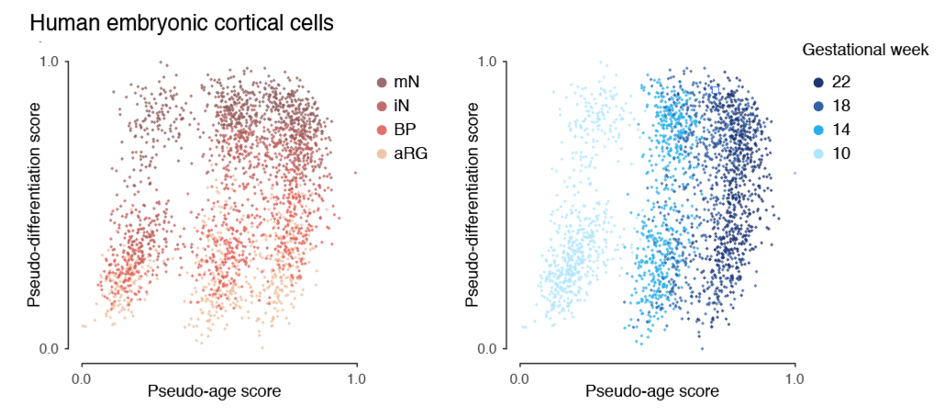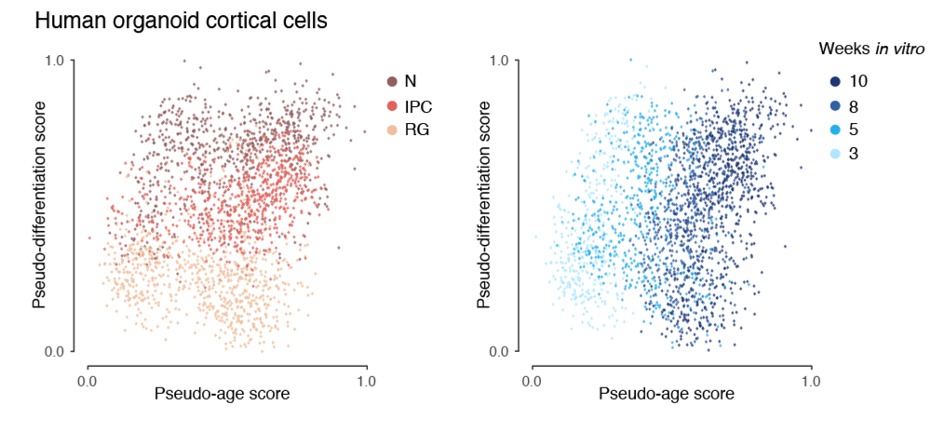This page contains companion data for our manuscript:
Mapping the molecular and cellular complexity of cortical malformations
E. Klingler, F. Francis, D. Jabaudon*, S. Cappello*; Science 2021Access Abstract and Full Text [here]
Query Developmental Genes:
Abbreviations
RG, radial glia; aRG, apical radial glia; vRG, ventral radial glia; oRG, outer radial glia; IPC, intermediate progenitor cell; BP, basal progenitor; N, neuron; iN, immature neuron; mN mature neuron.
Data sources
Mouse Embryo (FlashTag labeled cells):
L. Telley et al., Temporal patterning of apical progenitors and their daughter neurons in the developing neocortex. Science. 364, eaav2522–9 (2019).
Human Embryo:
T.J. Nowakowski et al., Spatiotemporal gene expression trajectories reveal developmental hierarchies of the human cortex. Science. 358, 1318–1323 (2017).
Human Organoid:
A.A. Pollen et al., Establishing cerebral organoids as models of human-specific brain evolution. Cell. 176, 743–756.e17 (2019).
Methods
To compare gene expression landscapes between species, we followed the same pipeline as in Telley et al., 2019, using published dataset from Nowakowski et al., 2017 (embryonic human cortex at 10, 14, 18 and 22 post-conception weeks) and Pollen et al., 2019 (cerebral human organoids at 3, 5, 8, and 10 weeks in vitro).
Note that while in Telley et al., 2019, mouse cortical neurons directly born from apical progenitors at specific embryonic stages were followed during their differentiation thanks to FlashTag labeling, the other datasets presented here comprise all cortical cell populations at each developmental stage.
For each dataset, a pseudo-age and a pseudo-differentiation scores were calculated as follow. Ordinal regression (bmrm R package) was performed using seed cells to build a pseudo-age / pseudo-differentiation model (see Telley et al., 2019 for details). The pseudo-age and pseudo-differentiation scores were then calculated as the predictions from these models for all the other cells of the datasets.
Embryonic human cortex
Cell types were defined as follow:
| Cell types | Subtypes annotated by the authors |
|---|---|
| aRG | vRG |
| BP | IPC-new, oRG |
| iN | IPC/newborn, Newborn |
| mN | Deep layer, Layer IV, Layer VI Pan-area, Parietal and Temporal, Upper Layer |
Models were built as follow:
- pseudo-age: 100 cells / embryonic stage (n = 25 aRG, 25 BP, 25 iN, 25 mN per embryonic stage)
- pseudo-differentiation: 200 cells / type
| Model classes | n cells per embryonic stage |
|---|---|
| aRG | 50 |
| BP | 25 oRG & 25 IPC |
| N | 25 iN & 25 mN |
Prediction scores:
 (n = 150 random cells per type and embryonic stage)
(n = 150 random cells per type and embryonic stage)
Cerebral human organoids
Cell types were defined as follow (low quality annotated cell subtype was excluded):
Models were built using n = 50 cells per in vitro stage and per cell type.
Prediction scores:
 (n = 200 random cells per type and in vitro stage - for IPC: n = 100 at 3, 150 at 5, 250 at 8 and 300 at 10 weeks in vitro)
(n = 200 random cells per type and in vitro stage - for IPC: n = 100 at 3, 150 at 5, 250 at 8 and 300 at 10 weeks in vitro)